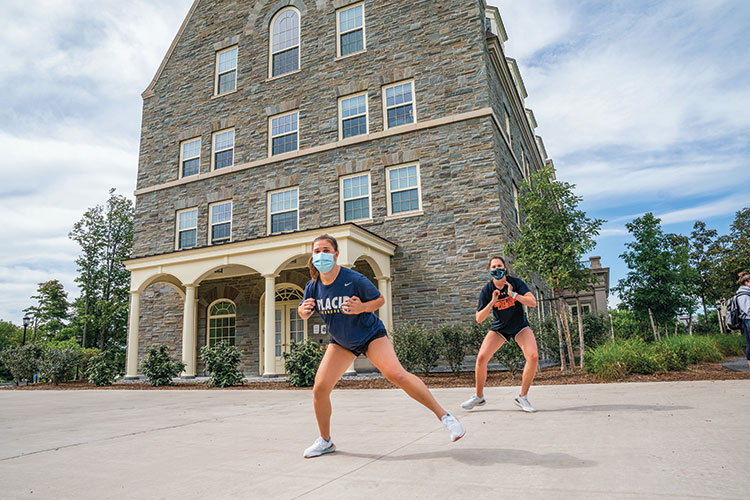The beginning of the academic year looked different at Colgate as students started the fall semester in a campuswide quarantine. It was an unprecedented step during an extraordinary time, with three dozen states listed under New York State’s COVID-19 travel advisory.
For weeks, University faculty and staff members worked on every aspect of the quarantine — even as they addressed the complex demands surrounding the remainder of the semester. Changes to life on campus required by responsible safeguards against the pandemic were significant and wide ranging, and they required collaboration among all members of the campus community.
All of this was part of an extensive effort addressing the economic, physical, emotional, and intellectual health of an entire student body. Steps taken to support Colgate students include:
- An increased financial aid budget by $1 million for the fall semester to address the needs of students whose fiscal situations have changed as a result of the pandemic.
- Colgate replaced work-study awards with grant aid for students who determined they should learn remotely this semester, and the University is creating new work-study opportunities on campus to replace student jobs that do not make sense in the context of the ongoing pandemic.
- Campus safety staff assembled 3,000 welcome bags, each containing two Colgate face coverings, a bottle of hand sanitizer, and a 3D-printed device that allows for touchless entry into many campus buildings. Bags were distributed as students checked in and signed up for their first round of on-campus COVID-19 testing. Snacks and water were present in residence halls on arrival day.
- The Colgate Bookstore made deliveries, with support from University staff. Textbooks and school supplies ordered in advance were placed in residence hall rooms prior to student arrival so that undergraduates would be ready for coursework when it began on Aug. 27.
- The counseling center prepared to support students in quarantine in many of the same ways it deployed during remote instruction last semester. Telehealth appointments were available for undergraduates as they navigated the first two weeks of life on campus — and beyond. Individual and group therapy sessions were available, and staff members took proactive steps to publicize tips for managing the emotional ups and downs of those challenging days between Aug. 23 and Sept. 8.
- Classes, even those with a live component after the campuswide quarantine, were remote for the first two weeks. “Faculty [members] focused on building [an] intellectual community in their courses even as students were learning from their rooms, and the academic work for those initial weeks were designed with the students’ quarantine context in mind,” says Lesleigh Cushing, Murray W. and Mildred K. Finard Professor in Jewish studies, professor of religion, and associate dean of the faculty for faculty recruitment and development.
- On arrival days, employees were out in force, coordinating traffic flow onto campus, facilitating the check-in process, moving possessions up the Hill, greeting and registering students who are beginning the on-campus COVID-19 testing protocol, and much more.
As President Brian W. Casey — who quarantined alongside students in West Hall — said in a town hall meeting early on: “We think that being together on a campus, even an altered campus, is a part of your education and development. Colgate, in 200 years, has never tried to do what we are about to try to do. This will be something you can look back on, hopefully with pride. We face extreme and daunting odds, but we are a team.”
Did you know?
Universal quarantine is something new in Colgate history, but the coronavirus itself has a longer past. According to Associate Professor of Biology Geoff Holm, the first disease identified to be caused by a coronavirus was an infectious respiratory disease in chickens, in North Dakota in 1931. The virus, infectious bronchitis, was isolated in 1933.

